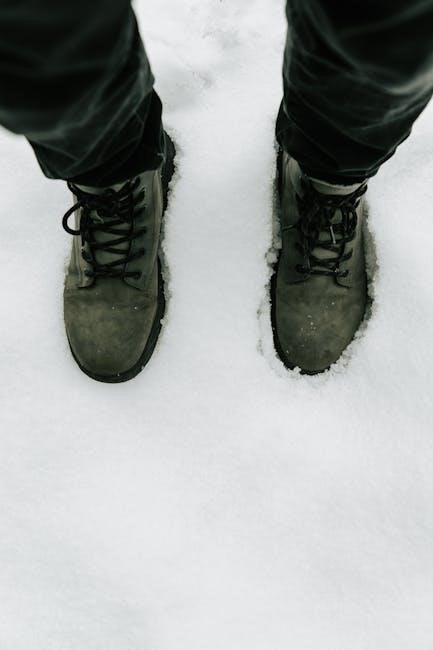Choosing the right snowshoe size is crucial for optimal performance and comfort. Size charts guide selection based on user weight, pack weight, and snow conditions to ensure proper float and maneuverability.
1.1 Importance of Choosing the Right Snowshoe Size
Choosing the right snowshoe size is essential for ensuring proper float, stability, and comfort on the snow. A snowshoe that is too small may struggle to stay afloat in deep snow, reducing efficiency and increasing fatigue. Conversely, a snowshoe that is too large can be difficult to maneuver, making it harder to walk or turn. Proper sizing also ensures that the snowshoe’s bindings can be adjusted to fit your boots securely, preventing blisters or discomfort during long treks. By selecting the correct size, you optimize your performance and enjoyment, whether you’re hiking, racing, or exploring winter landscapes.
1.2 Brief Overview of Snowshoe Sizing Factors
The size of a snowshoe is determined by several key factors, including the user’s weight, pack weight, and snow conditions. User weight, including the weight of clothing and gear, directly impacts the snowshoe’s ability to stay afloat. Pack weight adds to this, requiring larger snowshoes for heavier loads. Snow conditions also play a role; deep, powdery snow demands larger snowshoes for better floatation, while compact snow can be managed with smaller sizes. Additionally, the intended use, such as recreational hiking or competitive racing, influences size selection. Understanding these factors helps in choosing the appropriate snowshoe size for a comfortable and effective winter experience.

Understanding Snowshoe Basics
Snowshoes are lightweight frames with decking that distribute weight for easy movement on snow. They typically feature durable materials like aluminum or plastic and include crampons for traction.
2.1 What Influences Snowshoe Size?
Several factors determine the ideal snowshoe size. User weight and pack weight are primary considerations, as they affect flotation. Snow conditions, such as deep or powdery snow, require larger sizes for better buoyancy. The type of activity, whether recreational, racing, or backcountry, also plays a role. Additionally, the design of the snowshoe, including features like tapered tails or round tails, can influence size selection. Proper fit ensures comfort and efficiency, making it essential to consult size charts and consider personal preferences for optimal performance on the snow.
2.2 Types of Snowshoes and Their Size Requirements
Different snowshoe types cater to various activities and terrains. Recreational snowshoes, designed for casual use, typically range from 25 to 30 inches in length. Racing snowshoes are narrower and shorter, around 20-25 inches, for speed and agility. Backcountry models, built for deep snow and rough terrain, are larger, often 30-36 inches, to provide maximum floatation. Youth and child snowshoes are smaller, usually 16-20 inches, to suit younger users. Each type has specific size requirements based on user weight and intended use, ensuring optimal performance and comfort. Consulting a size chart helps match the right snowshoe to the user’s needs and preferences.
Determining the Right Snowshoe Size
Determining the right snowshoe size involves considering user weight, pack weight, and snow conditions. Larger snowshoes offer better float in deep snow, while smaller ones enhance agility on packed trails.
3.1 User Weight and Pack Weight Considerations
User weight and pack weight are critical factors in selecting snowshoe size. Heavier loads require larger snowshoes for better float, while lighter users can opt for smaller, more maneuverable options. Proper sizing ensures efficient movement and prevents sinking in deep snow, enhancing overall performance and comfort during winter adventures. Always refer to the size chart for specific recommendations tailored to your combined weight and intended use. This ensures a balanced and enjoyable snowshoeing experience.
3.2 Snow Conditions and Their Impact on Size
Snow conditions significantly influence snowshoe size. Deep, powdery snow requires larger snowshoes for better float, while compact or icy surfaces allow for smaller, more agile options. The type of snow—whether it’s light and fluffy or heavy and wet—affects how much surface area is needed for stability. Larger snowshoes provide more buoyancy in deep snow, preventing sinking and improving efficiency. Conversely, smaller snowshoes are easier to maneuver on packed trails or hard crust. Matching snowshoe size to snow conditions ensures optimal performance and comfort, making the adventure more enjoyable. Always consider the terrain and snow type when selecting your snowshoe size for the best experience.

Fit and Comfort in Snowshoes
Proper fit and comfort are essential for enjoyable snowshoeing. Bindings should securely hold your boots, and gait should allow a natural stride without restriction or discomfort.

4.1 How to Measure Your Foot for Snowshoes
To ensure a proper fit, measure your foot while wearing the same boots you’ll use for snowshoeing. Stand on a flat surface and trace your foot outline. Use a ruler to measure the longest point (heel to toe) and the widest point across the ball of the foot. Compare these measurements to the manufacturer’s size chart. Consider the boot’s bulk and how tightly they lace, as this affects the fit. If your foot shape is wider or narrower than average, choose a snowshoe with adjustable bindings for a secure fit. Proper measurement ensures comfort and prevents blisters during long treks.
4.2 Gait and Stride Considerations
When selecting snowshoes, consider your natural gait and stride to ensure a comfortable and efficient experience. A proper fit allows for a natural walking pattern without feeling restricted. Measure your stride length and assess how your feet naturally align when walking. If you have a wider or narrower gait, choose snowshoes with adjustable bindings to accommodate your movement. Additionally, consider the terrain you’ll be traversing, as deeper snow or uneven landscapes may require a slightly longer stride. Proper alignment and stride comfort prevent fatigue and discomfort during extended use. Ensure your snowshoes allow for a smooth, natural gait to maximize performance and enjoyment on the trails.
4.3 The Role of Bindings in Fit
Bindings play a crucial role in ensuring a secure and comfortable fit for snowshoes. They attach to your boots, holding them firmly in place while allowing natural foot movement. Properly fitted bindings prevent slipping and provide stability, enhancing control and maneuverability. Look for bindings that are easy to adjust and compatible with your boot size. Fixed rotation bindings are ideal for efficient stride, while full rotation bindings offer more flexibility. Adjust bindings snugly to avoid pressure points but not so tight that they restrict circulation. Ill-fitting bindings can lead to discomfort, blisters, or reduced performance. Ensuring your bindings are well-suited to your footwear is essential for optimal snowshoeing comfort and efficiency.

Choosing the Right Model for Your Needs
Selecting the right snowshoe model depends on your activity, terrain, and personal preferences. Consider floatation needs, traction features, and weight capacity for optimal performance in various snow conditions.
5.1 Snowshoe Size Chart: A Detailed Guide
A snowshoe size chart is essential for selecting the right fit. Typically, charts categorize sizes by user weight, pack weight, and snow type. For instance, smaller sizes (20-25 inches) suit lighter users (100-150 lbs) for packed snow, while larger sizes (30-36 inches) are ideal for heavier users (200-250 lbs) in deep, powdery conditions. The chart also considers flotation needs, ensuring the shoe’s surface area matches the weight it needs to support. By referencing the chart, you can determine the optimal size for your winter adventures, ensuring both comfort and efficiency on the trails.
5.2 How to Test Snowshoes at Home or in Store
Testing snowshoes ensures a proper fit and performance. At home, walk around to check comfort and mobility. In-store, wear winter boots to simulate real use. Pay attention to how they feel on flat ground and inclines. Ensure bindings are snug but not restrictive. Look for even flotation and easy maneuverability. If testing at home, check for adequate space to move without obstruction. Stores may offer trial areas to mimic trail conditions. This hands-on approach helps confirm the right size and model for your needs, ensuring confidence in your snowshoe choice.
Troubleshooting Common Sizing Issues
Common issues include snowshoes feeling too tight or loose. Adjust bindings for optimal fit and consult size charts to ensure proper weight distribution and comfort.
6.1 When Snowshoes Feel Too Tight or Too Loose
If snowshoes feel too tight, they may restrict movement and cause discomfort. If too loose, they can lead to poor control and inefficiency. Ensure proper fit by checkingBindings and size charts.
- Tight snowshoes: Adjust bindings or consider a slightly larger size for better mobility.
- Loose snowshoes: Tighten bindings or opt for a smaller size to enhance stability and performance.
Testing snowshoes in different conditions can help identify ideal fit and ensure optimal performance on the trail.
6.2 Adjusting Bindings for Optimal Fit
Properly adjusting snowshoe bindings is essential for comfort and performance. Ensure bindings are snug but not overly tight to avoid restricting movement or causing discomfort. Start by securing the toe strap firmly and adjust the heel strap for a secure fit. If bindings feel too loose, tighten them to prevent slippage during use. For optimal fit, wear the same boots you plan to use for snowshoeing when adjusting. If bindings are too tight, slightly loosen them to maintain circulation and flexibility. Testing adjustments by walking or simulating strides can help confirm the right fit. Properly fitted bindings ensure better control and efficiency on the trail.
Selecting the right snowshoe size ensures a comfortable and enjoyable experience. Always consult size charts, consider weight, and test fit to make informed decisions for optimal performance.
7.1 Final Tips for Selecting the Perfect Snowshoe Size
When choosing snowshoes, prioritize your weight and the conditions you’ll encounter. Use size charts as a starting point, but also consider testing pairs to ensure comfort. Proper fit is essential for performance and safety. Don’t hesitate to seek expert advice if unsure; Remember, larger snowshoes offer better float in deep snow, while smaller ones are more maneuverable. Always ensure bindings fit securely and allow for natural movement. Taking these steps will help you find the ideal size, enhancing your winter adventures with confidence and comfort.